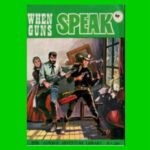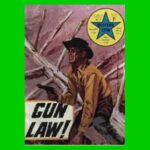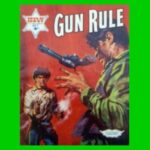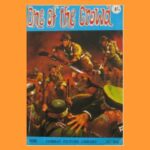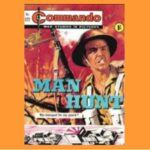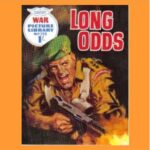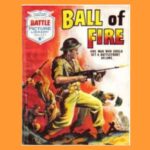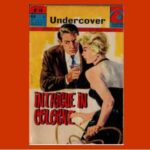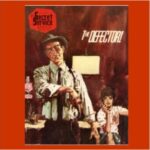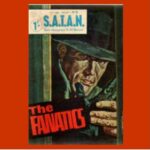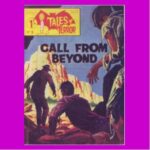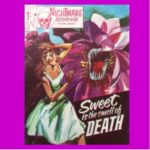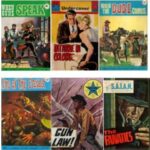Clicking on the following links or images will take you to the different lists of British picture libraries (B&W pocket-size comics) covered in this section:
|
(Western)
|
(Western)
|
(Western)
|
(War)
|
(War)
|
(War)
|
(War)
|
(Espionage)
|
(Espionage)
|
|
(Espionage)
|
(Espionage)
|
(Action/Crime)
|
(Action/Crime)
|
(Action/Crime)
|
(Horror/Suspense)
|
(Horror/Suspense)
|
(Combined)
|
|
(Western)
|
(Western)
|
|
(Western)
|
(War)
|
|
(War)
|
(War)
|
|
(War)
|
(Espionage)
|
|
(Espionage)
|
(Espionage)
|
|
(Espionage)
|
(Action/Crime)
|
|
(Action/Crime)
|
(Action/Crime)
|
|
(Horror/Suspense)
|
(Horror/Suspense)
|
|
(Combined)
|
While today’s comic books are generally published in a few recognizable formats, they once came in all shapes and sizes (and colors). This section contains an assortment of British comics published in the ‘picture library’ format that was introduced in the late 1950s and became very popular in the 1960s (outside the U.S.). However, with a few exceptions (notably Commando, which is still going strong), this comics format started to fade in the 1970s and it is now virtually extinct.
These British comics had a distinct identity from the U.S. ones, but nevertheless they were equally enjoyable and the writing and artwork were quite sophisticated. Among the features that distinguished the British comics from their U.S. counterparts were the following:
- They were ‘pocket size’, typically around 5″ x 7″ (compared with the 7″ x 10″ size of regular U.S. comics)
- They were all in black-and-white (compared with the full color format of most U.S. comics)
- They were usually undated, with multiple issues of each title published every month (sometimes as many as 4-6)
- They had 64 pages with 2 panels each (about the same number of panels as a regular US 22-page comic story with ~6 panels on each page)
The major publishers of these pocket-size B&W comics were: Fleetway, Micron, DC Thomson, M.V. Features, Famepress, World Distributors and Alex White. Sometimes, the comics passed on from one publisher to another while maintaining a similar look-and-feel, as in the case of Undercover, which transitioned through the last three publishers mentioned. All in all, considering the more limited audience for these British comics, their quality and appeal are quite remarkable.
The British comics covered in this section can be classified into four broad categories, as described below. (The date of first publication of each series in in parentheses after the comic title.)
Western
Cowboy Adventure Library (1964): Published by Micron, these comics featured tales of the American West. It lasted over three decades and numbered over 1,000 issues.
Western Star (1965): Published by M.V. Features, these comics featured tales of the American West. The series had a short run, lasting for about 2 years and numbering only 30 issues.
Wild West Picture Library (1966): Published by Fleetway, these comics featured tales of the American West. It lasted about 5 years and numbered 114 issues.
War
Combat Picture Library (1966): Published by Micron, these comics featured tales of combat, primarily during World War II. It lasted for more than three-and-a-half decades, numbering over 1,200 issues.
Commando (1961): Published by D.C. Thomson, the war comic Commando is still in print today more than six decades after its debut. It is thus the longest running comic series of all the British titles listed here: 62+ years and 5,600+ issues, and still going strong!
War Picture Library (1958): Published by Fleetway, these comics featured tales of combat, primarily during World War II. It lasted for more than 25 years, numbering over 2,100 issues.
Battle Picture Library (1961): Published by Fleetway, this sister publication to War Picture Library featured tales of combat, primarily during World War II. It lasted for more than 23 years, numbering over 1,700 issues.
Espionage
Undercover (1964): Published in turn by three different publishers (Famepress, World Distributors and Alex White), these comics featured tales of espionage and intrigue. It lasted for more about 5 years, numbering 140 issues.
Secret Service (1965): Published by M.V. Features, these comics featured tales of espionage and intrigue. The series had a short run, lasting for about 2 years and numbering only 28 issues.
S.A.T.A.N. (1966): Published by Famepress, these comics featured tales of espionage and intrigue. The series had a very short run, lasting for about a year and numbering only 16 issues.
Secret Agent Super Library (1967): Published by Fleetway, these giant-size comics featured tales of espionage and intrigue starring the two secret agents Johnny Nero and Barracuda. The series had a short run, lasting a little over a year and numbering only 26 issues.
Miscellaneous (Action, Crime, Horror, etc.)
Action Picture Library (1969): Published by Fleetway, these comics featured tales of action and adventure. The series had a short run, lasting about 2 years and numbering only 30 issues.
Scotland Yard (1965): Published by Famepress, these comics featured tales of crime and detection. The series had a short run, lasting just over a year and numbering only 24 issues.
Stupendous Super Library (1967): Published by Fleetway, these giant-size comics featured tales of action and adventure starring the two super-heroes Steel Claw and the Spider. The series had a short run, lasting a little over a year and numbering only 26 issues.
Tales of Terror (1966): Published by Famepress, these comics featured tales of horror and the supernatural. The series had a very short run, lasting about a year and numbering only 14 issues.
Nightmare Suspense (1966): Published by M.V. Features, these comics featured tales of horror and the supernatural. The series had a very short run, lasting for about a year and numbering only 16 issues.

